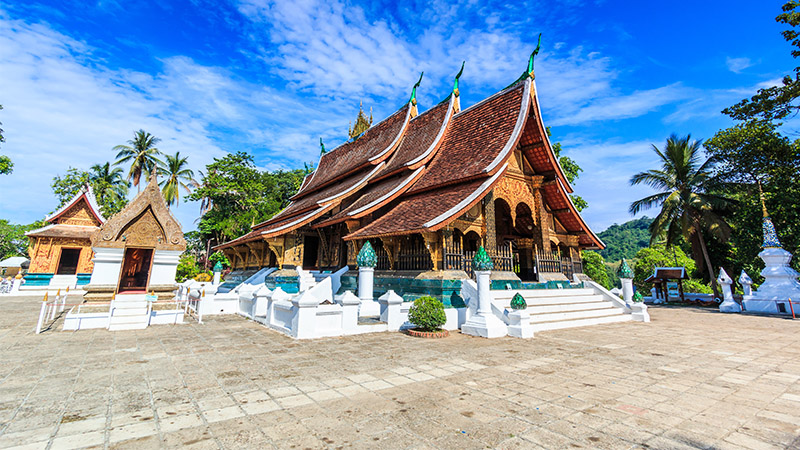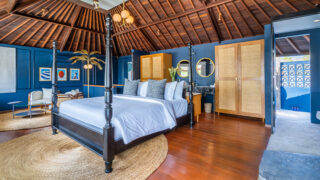Travelling to Laos? Maybe you’re eyeing off a long weekend in Luang Prabang? Or a visit to the capital, Vientiane? Here, EL staff and readers tell us where to go and what to do!
# Luang Prabang
From hospital to hotel luxury
Amantaka, the Aman Resorts property in Luang Prabang, takes its name from the Sanskrit words aman, “peace”, and tipitaka, “teachings of Buddha”. It’s a good fit, as more than 2,000 monks live in the town’s many temples.
As accommodation goes, Amantaka is equal parts glorious and quirky. Until 2005, this grand, century-old colonial property served as Luang Prabang’s main hospital. When a bigger premises was required for the hospital, the renowned Aman group transformed the site into the town’s most luxurious place to stay.

Set around a gigantic courtyard of lush gardens and candle-lit paths, the 24 stunning suites – 16 with private pools – are all louvres, high-ceilings, island bathtubs, four-poster beds and gentle gamelan music lilting down from Bose speakers. Apparently, there are four employees to each guest at Amantaka. Yet aside from the occasional smiling gardener under a conical hat, you barely see them. That’s unless you want to, at which time your request gets handled promptly and cheerily.
Things to do at Amantaka
There are plenty of activities available enhance your stay. I did a superb cooking class at Amantaka’s organic farm, recreating (to the best of my limited abilities…) four local dishes: moo phak sikai (braised pork in coconut milk), mok pa (steamed fish cakes), keng som kai (clear chicken soup) and tam mak hoong (green papaya salad).
I also took part in a Baci ceremony, which has its roots in animism, and takes place around a sacred silver receptacle (pa khouan) draped with flowers and food offerings. Amantaka’s cultural advisor and a trio of respected village elders led me through the ceremony – gentle chanting followed by the ritual tying of my wrists with short lengths of white cotton thread, for wellbeing and good luck.
The resort can also arrange bike tours of the town, or a leisurely boat trip upriver to caves and waterfalls. The latter gave me the chance to sample a popular Luang Prabang snack: fried river moss (known locally as khai paen; “skin of the stones”). It’s tasty stuff – like squares of Japanese nori sprinkled with sesame seeds and toasted – and the perfect accompaniment to a bottle of local brew Beerlao.

There’s no doubt that Luang Prabang (I’ll call it LP from now to save space) has a raft of much cheaper accommodation options – including some quaint looking guesthouses along the river. But if you want to maximise your experience of this special town, Amantaka is the place.
Shamus Sillar, Australian
The best way to experience the tak bak ceremony
At dawn, a procession of monks slowly enters the streets of Luang Prabang, their saffron robes rippling in the wind. In a ritual dating back to the time of the Buddha, the monks silently collect alms from the local townspeople, who receive merit towards their faith in exchange for their acts of selflessness and communalism. For many tourists in LP, the opportunity to witness the sacred alms ritual (or tak bak ceremony, as it’s known), is a highlight of their trip. To maintain the ritual’s spiritual integrity, know the following before you go:

#1 Arrive prepared
Buy your alms, which consist mainly of sticky rice, bananas and other foods, from your hotel the night before or at the local morning market. The monks actually eat these offerings, and for many they represent their daily food supply. So, don’t distribute anything you wouldn’t eat yourself.
#2 Don’t buy from morning vendors
Street vendors take advantage of the ceremony by capitalising on tourists, rather than giving to the monks themselves. Some have been known to sell unsafe rice to tourists, resulting in monks falling ill. Plus, your first bowl of rice may be cheap, but additional bowls of rice, crackers and flowers will come at a higher price, and you might find a large sum of money being demanded of you after the procession.
#3 Dress appropriately
Women must cover their shoulders, décolletage and knees. Hats should be removed.
#4 Show respect
Remove your shoes and kneel on the ground so you’re lower than the monks’ heads. Don’t speak to or touch the monks. And don’t point your feet towards them at any time, as this is considered a grave insult.
#5 Strongly consider observing, rather than participating
The alms ritual is a sacred rite – not a tourist attraction. Tourists are encouraged to sit back from the street, snap photographs without a flash, and quietly observe in an unobtrusive way. This will preserve the sanctity of the tradition for locals and tourists alike.
Monica Pitrelli, American
A stay at Rosewood Luang Prabang
Our trip started with a few days in Cambodia, followed by a few days in Luang Prabang. We flew on Lao Airlines. We stayed at Rosewood Luang Prabang, a quaint hillside resort. The suites are uniquely decorated, the staff are friendly and accommodating, and the Elephant Bridge Bar over the river is a divine spot for evening cocktails.
We had a wonderful guide who showed us around the town; he was a monk himself and very friendly, pointing out the cultural highlights along the way. While we were in town, we also had the chance to watch the giving of alms. In the evening, you should drop by the night market which is a fun family-friendly place to shop at. We recommend having dinner at Secret Pizza.

During our trip, we took a private long-boat cruise on the Mekong, which included a stop at a local village and the Pak Ou Caves. We also visited the Royal Palace Museum that offers an overview of the culture and history of the city, the historical Huan Chuan Heritage House, Wat Xieng Thong and the Traditional Arts and Ethnology Centre. On one afternoon, we visited the Mandalao Elephant Conservation, a new elephant sanctuary that offers a non-riding experience focused on education and elephant welfare.
Another great place to visit is Kuang Si Waterfalls where we swam and enjoyed a picnic at the base of the large waterfalls. We also stopped by the Laos Buffalo Dairy where our daughter got to milk a buffalo! After the tour of the dairy, we had a tasting platter of different buffalo milk cheeses, coffee and delicious homemade ice cream.
Maggie Kite, American
# Vientiane
The quiet capital
Vientiane: come for the excitement, stay for the … erm … Actually, nobody comes to Vientiane for excitement. This is a very sleepy place. As Southeast Asian capital cities go, it’s like the polar opposite of Bangkok, Hanoi and Manila. But hey, sleepy is good in my book. In fact, when you’ve been on the road for a while, or in and out of airports, sleepy can be just the tonic for a traveller.
There are a handful of things to do in Vientiane that take advantage of the city’s languid vibe. A good place to start is to visit a religious site. (Around two thirds of the country’s population is Buddhist.)

Wat Si Saket, which turned 200 last year, is the most famous temple in Vientiane. It’s understated and a little rundown, but the pretty courtyard houses thousands upon thousands of Buddha statues in niches, while the separate temple complex next door is home to a huge reclining (sleepy, perhaps?) Buddha.
Thanks to the French influence, you can find fantastic coffees and pastries in Vientiane. An old favourite for a long time was Le Banneton café, one block back from the Mekong on Rue Nokeokoummane. It has since rebranded as Café Vanille, but word is that the buttery croissants are still just as good. For a caffeine fix to break you out of your slumber, head to Naked Espresso.
Silk shopping and street eats
When it comes to shopping, silk is the big-ticket item in Vientiane, and there are several craft emporiums and shops where you can watch artisans at work, making modern cotton weavings with traditional motifs. It might be pricey, but Lao Textiles (laotextiles.com) is among the best regarded of these; it’s run by an American designer, Carol Cassidy. There are new socially conscious boutiques offering clothing and crafts by ethnic minorities too.
You’ll be hungry by now. For a taste of Laotian street food, try the national favourite dish of laap. That’s minced meat with roasted ground rice, lime juice and herbs, for those in the know. An easier option? A superb French-style baguette crammed with paté, pork, pickles and chillies. Also excellent are the many varieties of soup, and the lemongrassy Lao sausage (sai oua).

Speaking of beer, Vientiane’s waterfront isn’t the prettiest going around, but for a sundowner, there’s still something mesmerising about the wide sweep of the Mekong here. The atmosphere in the riverside bars tends to have a mellow charm – perfect for a cold Laobeer. There are nightly markets along the waterfront, too, for clothing, trinkets and souvenirs, if that’s your bag.
Shamus Sillar, Australian
Like this? Read more about Laos and other destinations in our Travel section.





